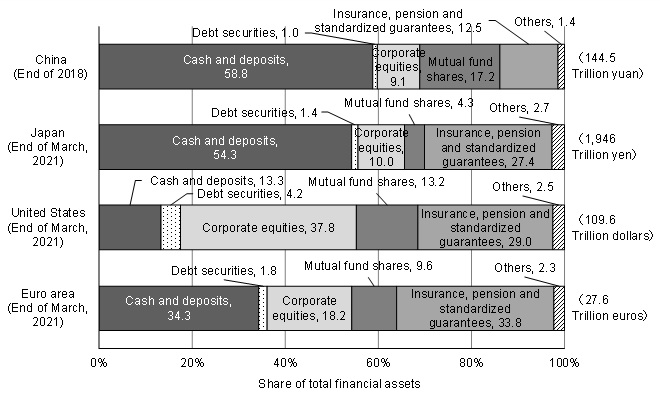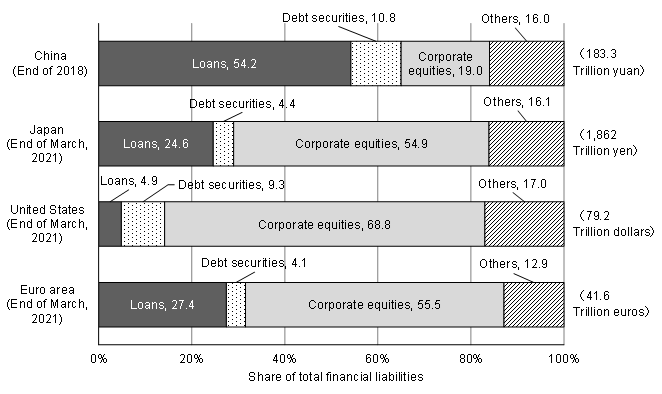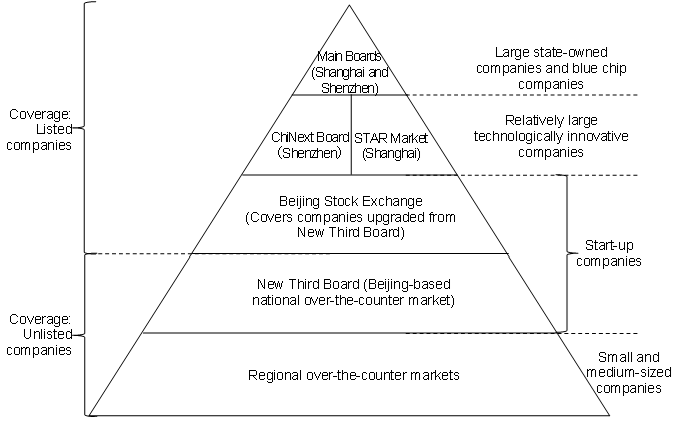I. Introduction
In China, the development of direct financing has lagged behind that of indirect financing. As a result, the financial system has failed to meet the diverse needs of investment and funding, especially in supplying risk capital to technologically innovative firms. Thus overreliance on indirect financing has hindered industrial transformation and upgrading. It has also increased systemic risk through the accumulation of debts owed by firms to banks.
To solve these problems, the government has positioned the shift from indirect to direct financing as a priority for financial reform. In the 14th Five-Year Plan (2021-2025), it has pledged to (1) fully implement a stock issuance registration system and expand financing channels through direct financing, (2) improve the multi-layered capital market system and inclusiveness of direct financing (3) improve the quality of listed companies and strengthen the basic system of direct financing, (4) promote innovative development in the bond market and enhance direct financing tools, (5) accelerate the development of private equity funds, and (6) promote the entry of long-term funds into the market and enhance the sources of direct financing (Note 1). Among these initiatives, improving the quality of listed companies is the key to the healthy development of direct financing.
II. China's Indirect Financing-centered Financial Structure
Direct financing refers to a company or other entity that raises funds through financial markets (stock markets, corporate bond markets, etc.), while indirect financing occurs when it raises funds through borrowing from banks and other financial institutions that collect deposits. China's financial structure is dominated by indirect financing, and this can be confirmed by checking the composition of financial assets of the household sector and financial liabilities of the nonfinancial corporate sector.
First, looking at the composition of the household sector's financial assets, in the case of China, the share of cash and deposits reached 58.8% (at the end of 2018), higher than in developed countries and regions such as Japan, the United States and the euro area (all at the end of March 2021), while the share of debt securities (bonds) and equities, etc. is low (Figure 1) (Note 2).

Next, looking at the composition of financial liabilities in the nonfinancial corporate sector, in the case of China, the share of loans is 54.2% (end of 2018), which is higher than in Japan, the United States, and the euro area (all at end of March 2021), while the share of equities and other assets is lower (Figure 2).

III. Aims of Promoting Direct Financing
The development of direct financing should contribute to industrial upgrading, a shift of funds from deposits to securities, and financial system stability.
1. Industrial upgrading
As shown by other countries’ experience, indirect financing, mainly through borrowing from banks, is better suited to mature, traditional manufacturing and real estate industries, whereas direct financing, mainly through issuing equity shares, is an important financing channel for emerging industries.
For banks, companies in mature traditional manufacturing and real estate industries, which have large amounts of tangible assets, are low-risk borrowers because they can provide collateral such as land, and their earnings are relatively stable. In contrast, innovative companies in the high-tech and modern service industries are high-risk borrowers to avoid because it is difficult to assess the value of their core assets, such as human resources and intellectual property, making it difficult to use them as collateral, and these companies also have difficulty turning expensive R&D investments into profits in a short time.
Direct financing, on the other hand, can be priced commensurately with the risk and can provide an efficient route to the procurement of risk capital for innovative firms, thereby promoting research and development and, ultimately, industrial upgrading.
2. Shift of funds from deposits to securities
For households, deposits provide a low-risk, low-return investment vehicle, while securities such as stocks and corporate bonds provide a high-risk, high-return investment vehicle. In China, which has experienced rapid economic development, the household sector is becoming more risk tolerant when investing its funds, leaving more room to shift funds from deposits to securities as the size of its assets grows.
However, in China, against the backdrop of an aging population, investable funds are increasingly concentrated among the elderly, who have low risk tolerance. In order to channel the funds that they have from indirect financing to direct financing, there is a need to develop financial products that reduce risk through diversified investments, such as mutual funds.
3. Financial system stability
For a long time in China, under a financial structure centered on indirect financing, corporate financing has been overly dependent on bank loans, leading to the accumulation of financial risks by banks. As emphasized by Guo Shuqing, Party Secretary of the People's Bank of China and Chairman of the China Banking and Insurance Regulatory Commission, the development of direct financing is not only expected to improve the allocation of funds in a way that meets the diversified needs of fund providers and fund users, but also to contribute to financial system stability by reducing corporate reliance on bank loans and improving corporate financial conditions (Note 3).
IV. Measures to Increase the Share of Direct Financing
In the 14th Five-Year Plan, increasing the share of direct financing has been identified as a priority for financial reform. To achieve this, the following issues must be addressed, according to Yi Huiman, Chairman of the China Securities Regulatory Commission (Note 4).
(i) Full implementation of a share issue registration system and expansion of direct financing channels
First, by referring to successful examples from overseas, reflecting China's characteristics and stage of development, and based on the trial experience of the STAR Board and the ChiNext Board, a registration system focusing on information disclosure should be implemented in all domestic stock markets. In addition, basic institutional reforms regarding issuance, listing, trading, and ongoing supervision and management should be promoted to ensure that each related party can fulfill its respective responsibilities, the market pricing mechanism can function more effectively, and more and more promising companies can grow through capital market financing.
(ii) Improvement of the multi-layered capital market system and the strengthening of the inclusiveness of direct financing
In order to increase the share of direct financing, it is necessary to establish a multi-layered capital market system that is highly inclusive and able to respond to the diverse financing needs of different types of firms and stages of growth (Figure 3). Toward this end, the reform of the main boards in Shanghai and Shenzhen should be promoted. At the same time, through innovations in the basic system, the Shanghai Stock Exchange Science and Technology Innovation Board (STAR Market) should be further developed, while the characteristics of the ChiNext board should be utilized to support the growth of technologically innovative enterprises. Furthermore, the New Third Board should be further reformed to strengthen its ability to meet the needs of SMEs, while at the same time normative off-exchange markets, such as regional over-the-counter markets should be developed. The financial derivatives markets should be reformed and their risk management mechanisms should be improved.

(iii) Improving the quality of listed companies and strengthening of the basic system of direct financing
First, mechanisms for the issuance of offered shares (capital increase), mergers and acquisitions, and equity compensation should be improved to support the transformation and upgrading of listed companies. In addition, the delisting system should be further improved, various exit routes should be developed, a permanent mechanism for delisting should be established, and the mechanism of natural selection should be strengthened. Furthermore, corporate governance reform of listed companies should be promoted and transparency in information disclosure should be enhanced. Companies leading in innovation and their industries should act as role models for others to follow. More and more companies should be encouraged to use direct financing as a means to achieve high quality development.
(iv) Promotion of innovative development in the bond market and enhancement of direct financing tools
First, the registration system for bond issuances should be improved, the interconnection of exchanges and interbank bond market infrastructure should be strengthened, and bank participation in bond trading should be supported. Development of asset securitization products should also be focused on. In the infrastructure sector, the scope of publicly offered real estate investment trusts on a trial basis should be expanded to establish a successful example as soon as possible. Furthermore, the scope of intellectual property securitization should be broadened to promote the practical application of scientific and technological achievements.
(v) Acceleration of the development of private equity funds
First, sources of funding should be actively developed, barriers to each process should be eliminated, including recruitment, investment, management, and exit, and private equity funds should be encouraged to invest in small, start-up, and high-tech companies. An administrative interim ordinance on private equity funds should also be issued, guiding them to continuously improve their professional operation and compliance awareness. Furthermore, cooperation among government agencies and between the central and local governments in dealing with risks should be strengthened, misconduct related to private placements should be eliminated, and the normative and healthy development of the industry should be promoted.
(vi) Promote market access to long-term funds and enhance direct financing sources
First, in order to secure long-term funds, the capacity of specialized asset management institutions should be enhanced, and efforts should be focused on developing mutual fund products that invest primarily in equities to promote the entry of medium- to long-term funds into the capital market. In addition, policies and guidance should be strengthened to increase the number of long-term oriented institutional investors and prompt a return to the key philosophy of value investing. Furthermore, outstanding foreign securities firms and asset management companies should be encouraged to enter the Chinese market in order to promote healthy competition in the industry.
V. Improving the Quality of Listed Companies
Among these measures, improving the quality of listed companies seems to be the key to promoting the development of direct financing.
In China's stock market, most listed companies are state-owned, and more than half of their outstanding shares are held by the government or by other state-owned companies. Corporate governance of these companies is usually weak, and as a result profitability is poor. Despite the implementation of "non-tradable share reform" in 2005, the situation has not changed significantly. Meanwhile, many fast-growing private companies have fled the Chinese market and listed on overseas markets, including in New York. Reflecting this phenomenon, which could be called "bad money drives out good" (Gresham's law), domestic stock prices have been stagnant for a long time and stocks have failed to attract investors, despite the high growth of the Chinese economy.
To improve the quality of listed companies, state-owned enterprises with lackluster performance should be delisted and the vigorous new listing of dynamic private companies should be actively promoted. As a first step, high-tech companies that are listed overseas, such as Alibaba and Tencent, should be encouraged to return to the Chinese market.


